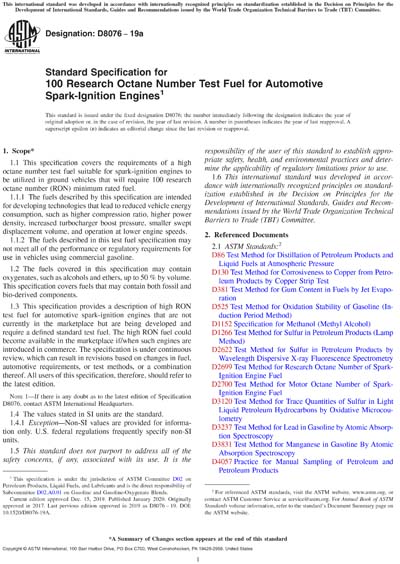Historical
ASTM D8076-19a
Standard Specification for 100 Research Octane Number Test Fuel for Automotive Spark-Ignition Engines
1.1 This specification covers the requirements of a high octane number test fuel suitable for spark-ignition engines to be utilized in ground vehicles that will require 100 research octane number (RON) minimum rated fuel.
1.1.1 The fuels described by this specification are intended for developing technologies that lead to reduced vehicle energy consumption, such as higher compression ratio, higher power density, increased turbocharger boost pressure, smaller swept displacement volume, and operation at lower engine speeds.
1.1.2 The fuels described in this test fuel specification may not meet all of the performance or regulatory requirements for use in vehicles using commercial gasoline.
1.2 The fuels covered in this specification may contain oxygenates, such as alcohols and ethers, up to 50 % by volume. This specification covers fuels that may contain both fossil and bio-derived components.
1.3 This specification provides a description of high RON test fuel for automotive spark-ignition engines that are not currently in the marketplace but are being developed and require a defined standard test fuel. The high RON fuel could become available in the marketplace if/when such engines are introduced in commerce. The specification is under continuous review, which can result in revisions based on changes in fuel, automotive requirements, or test methods, or a combination thereof. All users of this specification, therefore, should refer to the latest edition.
Note 1: If there is any doubt as to the latest edition of Specification D8076, contact ASTM International Headquarters.
1.4 The values stated in SI units are the standard.
1.4.1 Exception—Non-SI values are provided for information only. U.S. federal regulations frequently specify non-SI units.
1.5 This standard does not purport to address all of the safety concerns, if any, associated with its use. It is the responsibility of the user of this standard to establish appropriate safety, health, and environmental practices and determine the applicability of regulatory limitations prior to use.
1.6 This international standard was developed in accordance with internationally recognized principles on standardization established in the Decision on Principles for the Development of International Standards, Guides and Recommendations issued by the World Trade Organization Technical Barriers to Trade (TBT) Committee.
Content Provider
ASTM International [astm]






